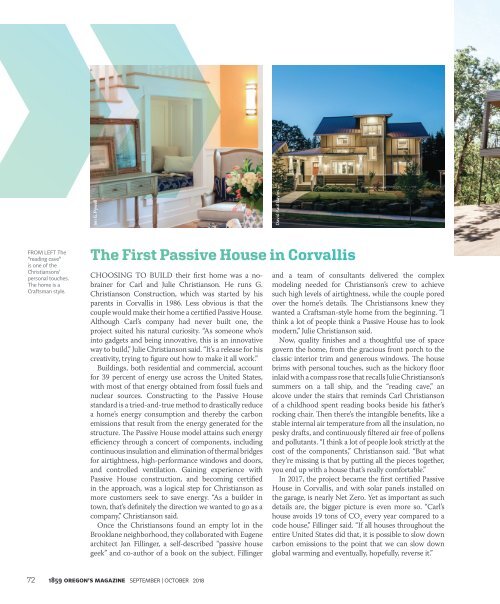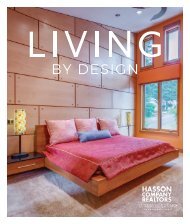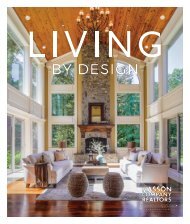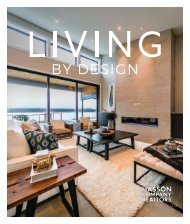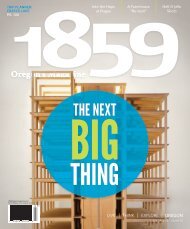Create successful ePaper yourself
Turn your PDF publications into a flip-book with our unique Google optimized e-Paper software.
Jen G. Pywell<br />
David Paul Bayles<br />
FROM LEFT The<br />
“reading cave”<br />
is one of the<br />
Christiansons’<br />
personal touches.<br />
The home is a<br />
Craftsman style.<br />
The First Passive House in Corvallis<br />
CHOOSING TO BUILD their first home was a nobrainer<br />
for Carl and Julie Christianson. He runs G.<br />
Christianson Construction, which was started by his<br />
parents in Corvallis in 1986. Less obvious is that the<br />
couple would make their home a certified Passive House.<br />
Although Carl’s company had never built one, the<br />
project suited his natural curiosity. “As someone who’s<br />
into gadgets and being innovative, this is an innovative<br />
way to build,” Julie Christianson said. “It’s a release for his<br />
creativity, trying to figure out how to make it all work.”<br />
Buildings, both residential and commercial, account<br />
for 39 percent of energy use across the United States,<br />
with most of that energy obtained from fossil fuels and<br />
nuclear sources. Constructing to the Passive House<br />
standard is a tried-and-true method to drastically reduce<br />
a home’s energy consumption and thereby the carbon<br />
emissions that result from the energy generated for the<br />
structure. The Passive House model attains such energy<br />
efficiency through a concert of components, including<br />
continuous insulation and elimination of thermal bridges<br />
for airtightness, high-performance windows and doors,<br />
and controlled ventilation. Gaining experience with<br />
Passive House construction, and becoming certified<br />
in the approach, was a logical step for Christianson as<br />
more customers seek to save energy. “As a builder in<br />
town, that’s definitely the direction we wanted to go as a<br />
company,” Christianson said.<br />
Once the Christiansons found an empty lot in the<br />
Brooklane neighborhood, they collaborated with Eugene<br />
architect Jan Fillinger, a self-described “passive house<br />
geek” and co-author of a book on the subject. Fillinger<br />
and a team of consultants delivered the complex<br />
modeling needed for Christianson’s crew to achieve<br />
such high levels of airtightness, while the couple pored<br />
over the home’s details. The Christiansons knew they<br />
wanted a Craftsman-style home from the beginning. “I<br />
think a lot of people think a Passive House has to look<br />
modern,” Julie Christianson said.<br />
Now, quality finishes and a thoughtful use of space<br />
govern the home, from the gracious front porch to the<br />
classic interior trim and generous windows. The house<br />
brims with personal touches, such as the hickory floor<br />
inlaid with a compass rose that recalls Julie Christianson’s<br />
summers on a tall ship, and the “reading cave,” an<br />
alcove under the stairs that reminds Carl Christianson<br />
of a childhood spent reading books beside his father’s<br />
rocking chair. Then there’s the intangible benefits, like a<br />
stable internal air temperature from all the insulation, no<br />
pesky drafts, and continuously filtered air free of pollens<br />
and pollutants. “I think a lot of people look strictly at the<br />
cost of the components,” Christianson said. “But what<br />
they’re missing is that by putting all the pieces together,<br />
you end up with a house that’s really comfortable.”<br />
In 2017, the project became the first certified Passive<br />
House in Corvallis, and with solar panels installed on<br />
the garage, is nearly Net Zero. Yet as important as such<br />
details are, the bigger picture is even more so. “Carl’s<br />
house avoids 19 tons of CO 2<br />
every year compared to a<br />
code house,” Fillinger said. “If all houses throughout the<br />
entire United States did that, it is possible to slow down<br />
carbon emissions to the point that we can slow down<br />
global warming and eventually, hopefully, reverse it.”<br />
72 <strong>1859</strong> OREGON’S MAGAZINE SEPTEMBER | OCTOBER <strong>2018</strong>


